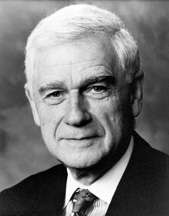Appropriations Committee Suite
| Building | United States Capitol |
|---|---|
| Location | Washington, DC |
| Country | United States |
| Named For | United States Senate Committee on Appropriations |
| Purpose | meetings |
The Appropriations Committee Suite is a suite of seven rooms in the United States Capitol used by the United States Senate Committee on Appropriations. Originally occupied by a variety of other Senate committees, the Appropriations Committee began moving into the rooms in 1911. The suite sits along the Brumidi Corridors.
History

The Appropriations Committee Suite was designed by Constantino Brumidi during the 1850s expansion of the Capitol and was originally used by a variety of Senate committees and offices. The Committee on Appropriations began moving into the rooms in 1911 from its former quarters on the second floor of the Senate wing of the Capitol and, by 1947, had occupied the entire suite.[1][2]
The Rooms
Daniel K. Inouye Room (S-126)
Room S-126 was designated the "Senator Daniel K. Inouye Room" in March 2013.[1]

Mark Hatfield Room (S-131)
Room S-131 was designated the "Senator Mark Hatfield Room" in September 1996.[1]
S-125
Along with S-125, room S-126 was formerly used by the Committee on the Judiciary.[1]
S-127

The main committee room, S-127, was first occupied by the Committee on Naval Affairs, and the art reflects a naval theme. The decoration is in a style derived from ancient Roman wall paintings in the Baths of Titus and the excavations of Pompeii. As originally designed by Brumidi, the upper walls were to be filled with depictions of U.S. naval battles in illusionistic porticoes. Because of dissatisfaction with the artists who were to have carried out the work, only one scene was completed. The highly ornate ceiling as executed by Brumidi and his assistants is painted in fresco and tempera. Seven Roman gods and goddesses of the sea, together with America in the form of a Native American woman, dominate the ceiling. Interspersed throughout are scenes of mermaids, centaurs, eagles, Native Americans, and settlers. The walls depict classical maidens in flowing robes with various naval instruments. Other original details in the room include the marble mantel, gilded mirror, and wooden shutters.[1]
The central chandelier, originally gas-burning and purchased in 1873 for the White House, was later acquired for the Capitol and modified for electricity. The room’s other dominant features include a blue, gold, and burgundy carpet inspired by the room’s design elements and the historic Minton tiles, and a 31-foot conference table at which each committee member has a designated place.[1]
S-128

A fresco entitled Bellona, the Goddess of War is located over the main entrance to S-128, reflecting the room’s original use by the Committee on Military Affairs. The room itself was decorated over a 15-year period by Brumidi and English artist James Leslie; Brumidi painted the lunettes with Revolutionary War scenes—the Boston Massacre, 1770; the Battle of Lexington (1775); Death of General Wooster, 1777; Washington at Valley Forge, 1778; and Storming of Stony Point, 1779—while Leslie painted the pilasters with elaborate military arms representing different historical periods. The ornate gilded valances and mirror over the marble mantel are also decorated with military accouterments. In a eulogy to Brumidi, shortly after his death, Senator Daniel W. Voorhees of Indiana praised the decorations and reflected: "who ever passed through the room of the Committee on Military Affairs without the feeling that the very genius of heroism had left there its immortal aspirations?"[1][3]
The elaborate floor tiles were manufactured by Minton, Hollins and Company of Stoke-Upon-Trent, England.[1]
S-129
The smaller room to the south of S–128, S-129, was assigned to the Committee on the Library at the time Brumidi painted the ceiling frescoes in 1875. The frescoes show allegorical figures of science, architecture, sculpture, and painting. After the ceiling was completed, the walls of the room remained undecorated for many years. It was not until 1910 that Carl Rakemann, whose father had worked with Brumidi, completed the decoration of the room. Since the room was used by the Military Affairs Committee at the time he worked on it, Rakemann chose a motif in keeping with the adjoining reception room, painting the four lunettes with portraits of outstanding Revolutionary War generals and historic flags. George Washington, Joseph Warren, Anthony Wayne, and Horatio Gates are depicted in each of the rooms’ four lunettes.[1]
S-130
Along with the adjacent Senator Mark Hatfield Room, room S-130 was once used by the Senate Majority Leader.[1]
References
- 1 2 3 4 5 6 7 8 9 10 The U.S. Senate Appropriations Committee (PDF). U.S. Senate. pp. 7–10.
 This article incorporates text from this source, which is in the public domain.
This article incorporates text from this source, which is in the public domain.
- ↑ Marter, Joan (2011). The Grove Encyclopedia of American Art, Volume 1. Oxford University Press. pp. 344–345. ISBN 0195335791.
- ↑ Carrier, Thomas (2000). The White House, the Capitol, and the Supreme Court. Arcadia. pp. 64–65. ISBN 0738505579.